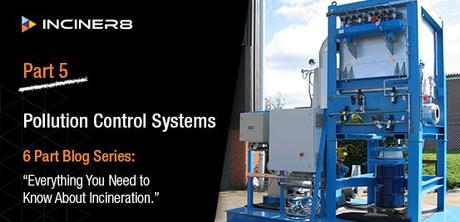
In this blog we will focus a method widely used to help control and reduce the emissions as much as possible to protect the environment and comply with legislation.
What are Pollution Control Systems?
Pollution control systems (PCS) can be added to your incinerator to regulate the emissions that are released into the atmosphere during the incineration process.
Our standard incinerator range is designed in a way that all exhaust gas has to pass through a secondary burner for complete re-burn of harmful gas components. Exhaust gases are then retained for a period of time at a high temperature (850 - 1200⁰C, depending on the application). This is what we call 'Basic' pollution control.
Dioxins, furans, and similar gaseous components are only destroyed by:
- Homogeneous high temperature (> 850⁰ C)
- Excess of oxygen (> 6%)
- Sufficient residence time at high temperatures
The three conditions listed above prevent dioxins from "cracking" into smaller but reactive dioxins, which can reform into new dioxin molecules, especially in the presence of heavy metals which can act as catalysts.
Although our incinerators are designed to produce the lowest emissions possible, in some countries you will require additional PCS to meet with local limits and thresholds.
Types of Pollution Control Systems
Pollution Control systems aren't just for incinerators but are widely used on a number of applications such as airplanes, trains, in factories, and other facilities. As a result, there is a large variety of PCS available.
At Inciner8 we have four main pollution control systems that can be added to your incinerator if necessary:
Small Pollution Control Systems
Our small pollution control system is designed for low flow rates and smaller waste batch sizes. This 120 filter element model can be used with most smaller incinerators to control emissions.
This PCS is designed to capture all the gases, soot, and entrained solids emitted by the incinerator while burning a low plastic content RDF mix and process it to meet European regulations. The regulations are set out in directive 2000/76EC, dated 4 th Dec 2000.
This medium, 230 element filter model pollution control system, was built to capture and clean the gases generated from burning a mixture of medical waste (primarily soiled bandages). This PCS is a suitable solution for most medical processes, dependant on the waste stream and volume.
Some key features of this PCS are:
- Custom designed separator system for specific waste streams
- Removes condensed heavy metals as particulates in the filter
- 230 individual filter elements
- Removes acid gases by reaction with hydrated lime and capture of the resulting solid
Large Pollution Control Systems
Our large pollution control system is one of the largest PCS systems we have developed. The 320 filter element model is capable of handling has from our 1000kg per hour machines. This unit features a large filter array and additional heat exchanger to reduce gas temperatures to the required levels for cleaning.
With a custom designed separator system for specific waste streams, our large pollution control system can be used with our largest incinerators to control emissions.
Venturi Scrubbers
Venturi Scrubbers use a combination of vortex technology and high pressure water misting to remove harmful elements from the exhaust gases. For a less demanding, lower throughput gas cleaning system, the venturi scrubber is a well-tested and respected design used by many industrial processes.
What makes this Venturi so special?
Through a combination of R&D and CDF modelling we have enhanced our venturi to incorporate a new spray head that has been optimally designed to cope with the demands of operating continuously within a waste sector.
The atomized liquid provides an enormous number of tiny droplets for the dust particles to impact on. These liquid droplets incorporating the particles must be removed from the scrubber outlet stream.
How does it work?
The key to successful operation is ensuring there is a continual flow of air and water made available to the venturi scrubber.
As the gas stream is introduced into a scrubber box, it is forced to pass through a converging section, where (in accordance with Bernoulli equation) gas stream velocity is rapidly increased. The throat section between pipes is where particle and gas removal occur as the inlet gas stream mixes with the fog of tiny liquid droplets.
- Entering the diverging section, the gas stream is forced to slow down
- Scrubbing liquid is introduced into a system using a high pressure pump and a set of micronic nozzles.
- Energy from the gas stream is used to additionally atomize water droplets.
- Part of the scrubber liquid that does not evaporate in the process is released from the system using specially designed valves on the bottom of the scrubber box.
This blog is of a 6 part series on "Everything You Need to Know About Incineration", brought to you by our expert technical team at INCINER8.
Click the links below to read:
